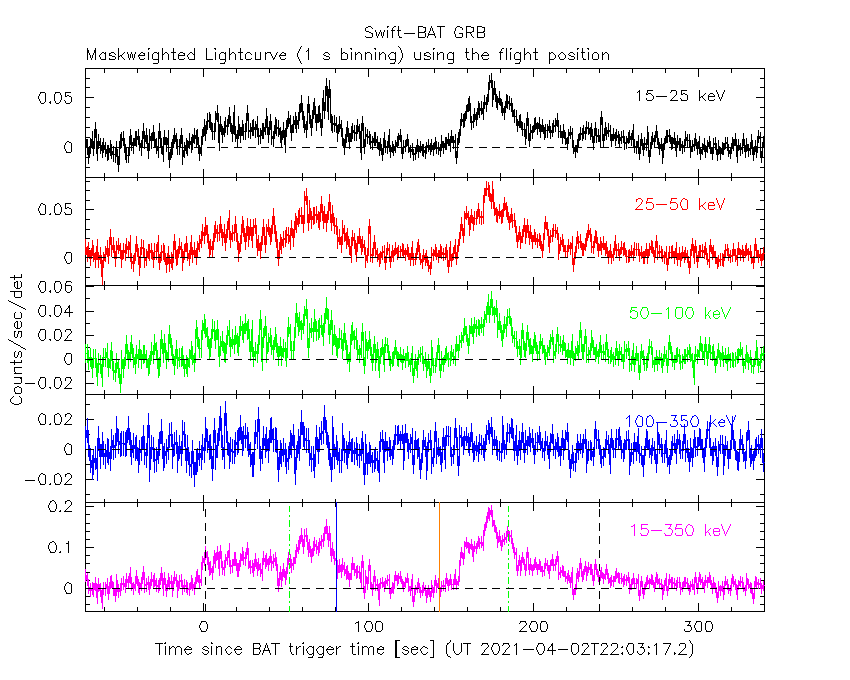
K.L. Page (U. Leicester), P.A. Evans (U. Leicester) and S.J. LaPorte (PSU) for the Swift team
Page et al. (GCN Circ. 29743) reported the initial Swift results. BAT has triggered on a new GRB 210402A (Trigger #1040123) causing Swift to slew to the location and make follow-up observations. Table 1 contains the best reported positions from Swift, and the latest XRT position can be viewed at http://www.swift.ac.uk/xrt_positions.
Xu et al. (GCN Circ. 29757) reported the position from NOT for the optical afterglow of this GRB. Table 2 is a summary of GCN Circulars about this GRB from observatories other than Swift.
Standard analysis products for this burst are available at https://gcn.gsfc.nasa.gov/swift_gnd_ana.html.
As reported by Laha et al. (GCN Circ. 29761),
the BAT ground-calculated position is RA, Dec = 198.265, 44.510 deg which is RA(J2000) = 1
The mask-weighted light curve (Figure 1) shows a multi-peaked structure that starts at ~T-50 s and ends at ~T+310 s.
The main peak occurs at ~T+174 s.
The time-averaged spectrum from T-51.60 to T+310.20 s is best fit by a power law with an exponential cutoff.
This fit gives a photon index 1.49 ± 0.27, and
The results of the batgrbproduct analysis are available at https://gcn.gsfc.nasa.gov/notices_s/1040123/BA/.
Analysis of the initial XRT data was reported by Evans et al. (GCN Circ. 29750). We have analysed 24 ks of XRT data for GRB 210402A, from 160 s to 339.9 ks after the BAT trigger. The data comprise 1.1 ks in Windowed Timing (WT) mode with the remainder in Photon Counting (PC) mode.
The late-time light curve (Figure 2) (from T0+5.4 ks) can be modelled with a power-law decay with a decay index of α=0.93 ± 0.13.
A spectrum formed from the WT mode data can be fitted with an absorbed power-law with a photon spectral index of 1.811 (+0.027, -0.026). The best-fitting absorption column is 3.25 ± 0.13 x 1
A summary of the PC-mode spectrum is thus:
Total column: 3.5 ± 0.8 x 1
Galactic foreground: 1.5 x 1
Excess significance: 7.3 σ
Photon index: 2.19 (+0.20, -0.19)
The results of the XRT team automatic analysis are available at http://www.swift.ac.uk/xrt_products/01040123.
The Swift/UVOT began settled observations of the field of GRB 210402A 73 s after the BAT trigger
(LaPorte and Page GCN Circ. 29764).
No optical afterglow consistent with the XRT position (Evans et al. GCN Circ. 29750) is detected in the initial UVOT exposures.
Table 3 gives preliminary
magnitudes using the UVOT photometric system
(Breeveld et al. 2011, AIP Conf. Proc., 1358, 373).
No correction has been made for the expected extinction in the Milky Way
corresponding to a reddening of

Figure 1. The BAT
mask-weighted light curve in the four individual and total
energy bands. The units are counts

Figure 2. The XRT light curve.
Any data from a crosshatched region are not included in the fit.
| RA (J2000) | Dec (J2000) | Error | Note | Reference |
|---|---|---|---|---|
| 1 |
+44°30'52.3" | 2.0" | XRT-final | UKSSDC |
| 1 |
+44°30'52.3" | 2.0" | XRT-refined | Evans et al. GCN Circ. 29750 |
| 1 |
+44°30'36.1" | 1.2' | BAT-refined | Laha et al. GCN Circ. 29761 |
| Band | Authors | GCN Circ. | Subject | Observatory | Notes |
|---|---|---|---|---|---|
| Optical | Lipunov et al. | 29741 | Swift GRB210402.92: Global MASTER-Net observations report |
MASTER | |
| Optical | Zhu et al. | 29745 | NOT optical upper limits | NOT | upper limits |
| Optical | Leonini et al. | 29747 | Montarrenti Observatory upper limit | Montarrenti | upper limits |
| Optical | Butler et al. | 29752 | DDOTI Upper Limits | Deca-Degree Optical Imager | upper limits |
| Optical | Rossi | 29753 | LBT observations | LBT | |
| Optical | Hu et al. | 29755 | BOOTES-network early optical upper limit | BOOTES | upper limits |
| Optical | Xu et al. | 29757 | NOT optical afterglow candidate | NOT | detection |
| Optical | Zhu et al. | 29762 | Further NOT optical observations | NOT | detection |
| Optical | Zhirkov et al. | 29765 | MASTER prompt and follow up optical observation |
MASTER | |
| Gamma-ray | Roberts and Meegan | 29763 | Fermi GBM detection | Fermi GBM | Fluence=1.699±0.008x1 |
| Filter | Exp(s) | Mag | ||
|---|---|---|---|---|
| whit |
163 | 313 | 147 | >20.8 |
| 321 | 571 | 246 | >20.3 | |
| white | 163 | 1718 | 411 | >21.4 |
| v | 653 | 5581 | 229 | >19.6 |
| b | 578 | 1694 | 117 | >20.2 |
| u | 321 | 1669 | 304 | >20.2 |
| w1 | 1108 | 1644 | 78 | >19.2 |
| w2 | 1207 | 1227 | 19 | >18.4 |
Table 3. UVOT observations reported by LaPorte and Page (GCN Circ. 29764). The start and stop times of the exposures are given in seconds since the BAT trigger. The preliminary 3-σ upper limits are given. No correction has been made for extinction in the Milky Way.
April 7, 2021